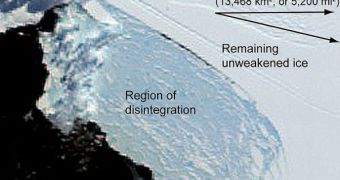The Wilkins Ice Shelf, a large chunk of ice measuring 80x60 nautical miles (150x110 kilometers), is set to break loose from the two Antarctic islands to which it's connected. At this point, the only thing holding the massive block in place is a thin stretch of ice, measuring only 500 meters across, at its narrowest. In the past, the strip of ice was more than 100 kilometers wide, but recent exacerbation in the influence of global warming has reduced it considerably.
Experts from the British Antarctic Survey (BAS) admit that there's nothing anyone can do for the ice at the moment, and say that “We've come to the Wilkins Ice Shelf to see its final death throes.” They reveal that the portion of ice connecting the islands to the shelf is more than 25 miles (40 kilometers) long, which means that a width of 500 meters couldn't possibly support it for very long.
In addition, recent satellite images, taken on November 26th, have showed the extent of the damage and the fact that the separation and sinking of the ice are inevitable. According to the same data, in 2008 alone the Wilkins ice shelf lost more than 772 square miles (2,000 square km) of its surface. The European Space Agency (ESA) made the announcement as soon as the data was in, and it took three days to get across the world.
BAS glaciologist David Vaughan, the leader of the British expedition, says that sediment testing has proved that some of the ice shelves that were lost last year were as much as 10,000 years old, and that the amounts that melted in 2008 summed up to about 25,000 square kilometers. “This ice shelf and the nine other shelves that we have seen with a similar trajectory are a consequence of warming,” he argues.
“It's very unlikely that our presence here is enough to initiate any cracks. But it is likely to happen fairly soon, weeks to months, and I don't want to be here when it does,” the scientist emphasizes while standing on a 2 kilometer-wide portion of the ice strip, alongside two reporters from Reuters. He estimates that the shelf could come off in a matter of weeks, or maybe months, and adds that the floating Wilkins Ice Shelf is highly unlikely to see the beginning of 2010.

 14 DAY TRIAL //
14 DAY TRIAL //